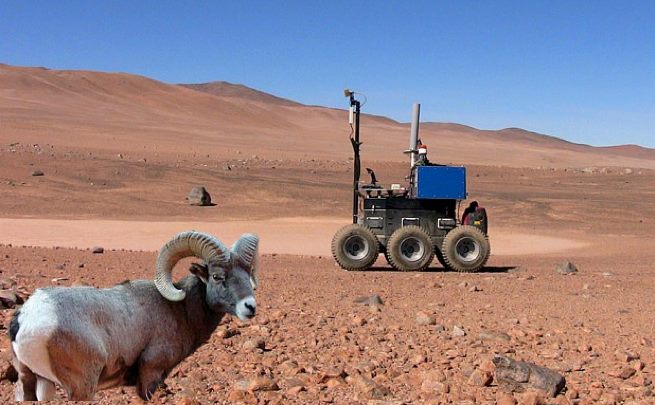Invisible Life: Life on Mars
We are Alexa Boesel, Oliver Goodman, and Fred Cohan from Wesleyan University in Connecticut, and here is our next story for Invisible Life.
About 34 million miles away from Death Valley National Park roams the Mars Rover Opportunity in search of any indications of life. If there is life on Mars, it is likely a form of invisible life – so far no Bighorn Sheep roaming around the Martian desert have been spotted.
But what does the search for life on Mars have to do with microorganisms living in Death Valley?
In the past 10 years, scientists have researched evaporites – minerals that microorganisms leave behind from organic processes – in Badwater Basin of Death Valley. Badwater gets its name from the high content of sulfur, metals, and salts found within, creating a unique, almost extraterrestrial environment. Dr. Susanne Douglas and her colleagues have studied Rosickyite, an unstable polymorph of sulfur produced by cyanobacteria found in Badwater Basin. Note that cyanobacteria is an umbrella term for bacteria that photosynthesize and create oxygen as a byproduct. While normally Rosickyite is not thermodynamically stable and quickly deteriorates on Earth, in Badwater, this community of cyanobacteria creates a stable sulfide-oxygen gradient environment. Gypsum in the ground dissolves to sulfide, and then sulfide is reoxidized to create Rosickyite. Rosickyite is sustainable in Badwater only because of the oxygen-sulfide gradient that the cyanobacteria create and the special geochemical conditions of water, alkaline pH, and sulfide.
Knowing how communities of microorganisms leave behind precipitates in places like Badwater Basin can help astrobiologists identify “markers” – or signs – of past life on Mars. All this research in Death Valley leaves us with one question:
Will a rover searching the seemingly barren Martian landscape find any Rosickyite – or possibly some other substance – that could be an indication of life existing elsewhere in the solar system?
Further reading:
Abstract: http://geology.gsapubs.org/content/30/12/1075.abstract
Photo credit to Ivan from Creative Commons and the National Park Services
Originally posted on Death Valley’s facebook page on February 23, 2015



